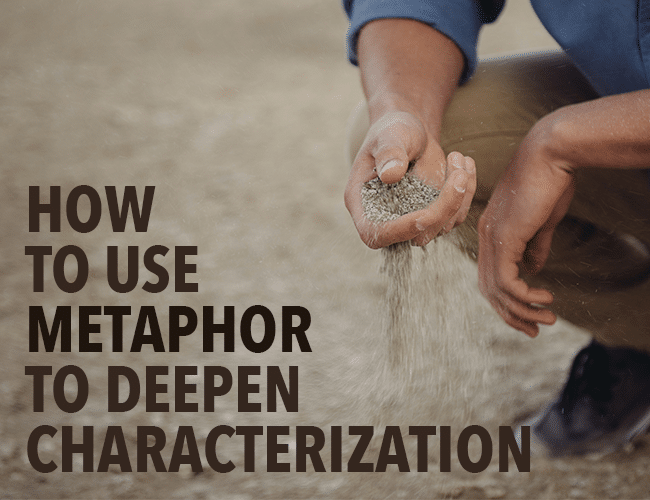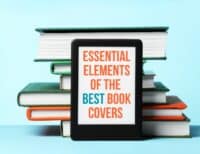As a prose writer, I try to suss out where I can deepen and expand my stories, transform a limping clause into a sure-footed guide. Sometimes, as in the preceding sentence, I find metaphor to be the most efficient and evocative tool in my writer’s gym bag.

I say gym bag rather than toolkit because toolkit is overused these days, seen too often to register. Just as noted in this post about similes, overuse leads to cliché.
My brother Gerald is the black sheep of the family. Certainly this is accurate: black sheep stand out amidst a flock of their white-fleeced relatives. But today’s readers won’t stop to think about that, and the writer’s opportunity for powerful connection is diminished.
Metaphor Connects With Readers
Metaphor, by conflating two unlike things—often an abstraction like love and a concrete object like a rose (thank you, Shakespeare)—invites readers to connect with our stories via the boundless power of imagination. Or, as James Woods says in How Fiction Works, “[m]etaphor . . . is the entire imaginative process in one move.”
In other words, metaphor helps our stories run smoothly, with steady footing across even the rockiest of terrain, bringing our readers to those stunning vistas seen only from mountaintops.
At this point, some of us may think, vistas? I’m writing a cozy mystery; metaphor is for high-falutin’ literary writers. I don’t believe it matters whether we’re we’re journeying in the land of so-called genre fiction or lyrical prose; we want to connect with our readers and so we need to be able to use whatever craft elements will most effectively guide our readers.
Discover Unseen Metaphors
OK, but how do we get to those vistas, as we stumble and slip on the narrow switchback paths of language, words, sentences? My experience with revision suggests attending to our verbs can reveal our stories’ metaphors—metaphors we didn’t even know we were making.
What? Yes! More often than not, I find I’ve created metaphors without setting out to do so.
When I finished the third draft of my first (unpublished, practice) novel, I set out, in my fourth draft, to scrutinize my verbs. I did this scene by scene, in ten-minute work sessions, using my beloved felt-tipped lime green pen to circle each and every verb. Then I listed out all the scene’s verbs on a clean sheet of paper.
Lo and behold: I had consistently given my protagonist, Claire, verbs suggestive of archeology. She “unearthed” items in her backpack, “dug out” from a pile of paperwork, “dusted off” a romantic interest.
I had not consciously decided to make Claire a student of the past, but this revision work revealed my subconscious had an understanding of her I had failed to notice.
I extended this metaphor by choosing one of the verbs that most strongly resonated with me (unearth) and then going to my thesaurus and writing all its synonyms on a separate sheet of paper: dig up, uncover, discover. Discover led to find, locate, pinpoint, surprise, turn up, sight, strike, retrieve, scavenge, come upon, encounter, chance upon, alight upon, stumble upon, detect, scent, sniff, descry, spot, trace, track, ferret out, discern, perceive, ascertain, divine, learn, tell, unravel, fathom, plumb, verify, deduce, analyze, diagnose.
Metaphors Lead to Characterization
With this list in front of me, I made metaphors by combining these concrete verbs with a theme I already knew the novel had: love.
She stumbled upon love. She divined love. She pinpointed love. She retrieved love. She stumbled upon love. She unraveled love.
Each of these elicited a very different feel for me, suggestive of different elements of my character, her approach to love and the direction I wanted to point my readers toward. I thus had the opportunity to choose which one came closest to making Woods’ “one imaginative move.” My novel became richer and deeper.
All well and good, but what if the archeology metaphor hadn’t been in line with Claire’s story? I’d have discovered that my verb choices didn’t support my book, and I’d be doing everyone a favor by swapping them out for some that would.
And what if my verbs hadn’t revealed any metaphor whatsoever, or what if my draft was still full of “to be” verbs? No worries. We can still find a path by making metaphors.
5 Steps to Uncover Metaphors that Enrich Your Writing
The key to uncovering enriching metaphors is to not overthink your writing. As you follow these five steps, let your imagination run amok!
1. Get to know your character.
Before you start seeking out metaphors for your work in progress, it’s best to finish your first draft. At the very least, write a passage long enough to give you material to play with.
If you’re looking to practice making metaphors on the side, character prompts are a great place to start. For example:
X (verb) his eggs on Sundays.
X celebrates her/his birthday by (gerund (-ing) form of verb).
X won’t be able to (verb) after the operation.
X takes his/her sweet time when (gerund verb) the punching bag.
2. Look for delightful verbs.
In your work in progress or your character prompt practices, pick the verb that you are most delighted by. Look it up in your thesaurus, listing all its synonyms.
3. Build synonyms into metaphors.
List at least five abstract ideas you feel passionately about: justice, freedom, friendship, love. Combine them with the synonyms you found. For instance, “X uncovers love.”
Voilà: a metaphor!
4. Read your metaphors aloud.
Once you’ve created several metaphors, read them all aloud. Which one best represents Woods’ “entire imaginative move”?
5. Explore your metaphor through free writing.
Use the metaphorical clause you’ve chosen as the prompt for a five-minute free write. Again, don’t analyze: just write.
A Process of Discovery
As you walk through this exercise, you’ll learn about your character and the scenes in your story. You might find the metaphor is unexpectedly effective, or the exercise might reveal the metaphor doesn’t hold.
Either way, remember that metaphor-making is a process of creativity and discovery. Give yourself permission to play with your writing. Who knows? You might stumble across something wonderful.
What metaphors have you used in your own writing? Let me know in the comments.
PRACTICE
It’s your turn to craft evocative metaphors. Take fifteen minutes to follow the first three steps:
- Complete the character prompts above.
- Pick your favorite verb from the bunch and look up its synonyms.
- Combine those synonyms with abstract ideas like freedom and truth.
Share your metaphors in the comments below, and be sure to leave feedback for your fellow writers. Which metaphors resonate with you and capture an “entire imaginative move”?
BONUS: If you finish with extra time on your timer, work your way through all five steps and share your free writing. Or, complete this exercise using your work in progress instead of the character prompts.







Whoever ‘Guest Blogger’ is… I suggest he/she has accomplished something worthwhile here. In my opinion, it’s the all too predictable verb usage that renders our writing commonplace. I love the idea of going through the manuscript with a GREEN pen — different colours for different grammatical elements? — and amping up the metaphors. Good work, G.B.
Thank you, PJ. Different colored pens for different grammatical elements has helped me figure out all kinds of things about my writing–nothing like visual representation to heighten my awareness of “to be” verbs, adverbs (fie!), gerund forms, etc.
I also like the idea of different colored pens, I use them for the different characters and their dialogue, as well as everything about them in a story/ scene. I dont think I’ve used Green for anything lately tho,,, nice call.
Scrivener has a nice highlight feature for tracking themes etc. with color 🙂
cant afford Scrivener not on my salary…. I either use celtx or Ms Word. Celtx has script lay out , notes, index cards , it was on another computer unfortunately I dont have that pc anymore….. it had to go into the shop.
Actually, when I was in grad school slogging through a never-ending Victorian Lit class, I used this same technique. In early chapters, I noticed which types of metaphors were used more than one time and then followed them through the novel. For example, I wrote down everything that was red. I wrote down every ship or nautical or water analogy. Sometimes I found that the metaphors themselves had an arc.
Great way to understand what another writer did, and figure out how they did it. I love deconstructing books, and haven’t done it with metaphor yet. I will try this one!
Great advice! I’m so bad at using metaphors that I don’t use them at all (at least not intentionally). You give us plenty to think about, and possible practice, here.
Jason, glad this was useful to you. Starting to think about any element of craft, and then noticing and using it deliberately, is a process–I hope you enjoy playing with noticing metaphor in your writing, and in that of authors you love reading.
This is the second article about metaphors I’ve read on TWP, and I still don’t get them. The closest I can get is this: To me, metaphors are the advanced trigonometry of writing.
I learned metaphors and similes in public speaking and still get them confused…. so your not alone.
It’s not that I don’t know the difference between a simile and a metaphor. But using a verb like “discover” and saying that is a metaphor doesn’t make much sense to me. Maybe these kinds of metaphors just aren’t part of my “voice?” (That feels more like a metaphor, as I type it.) Or maybe the energy I’m spending trying to comprehend these concepts would be better spent writing?
I can agree with that,,, I’ve been going over my stories now that nano is over to see what I can work on, the nano story didn’t go as far as I had hoped.
Sorry you didn’t get as far as you hoped with Nano. I trust you learned from the experience.
Yea its often frustrating…. Soon I will look at it again and finish it.
Bruce, time spent writing v. wrapping our brains around concepts is always time well-spent, IMO 🙂 I agree the example of “discover” as a verb/metaphor isn’t the strongest–but a verb like “spy” for example, with its implied disguise and info-gathering for a clandestine organization, can create metaphor when we use it in connection with a non-espionage context (metaphor so often being about joining a dissimilar idea/image/object). So if we have a baby spying on its parents, we make the baby an espionage agent, a (possibly) interesting connection.
Do you ever read poetry? I have found much of Billy Collins’ work to be both easily-accessible (e.g, I don’t need a degree in literature to understand what he’s saying!) and rich in metaphor.
Onward! Write write write!
I guess it’s the dissimilar part I don’t get. That, and using verbs as metaphor.
Yes, I read poetry. I’ve recently discovered the works of August Derleth, which are very accessible.
Never heard of Derleth, I’ll look up some poems!
I say if this, or any other, “craft” exercise/concept isn’t helpful to you, don’t sweat it. Read authors you love, figure out how they make their stories work, try those same moves in your own writing, get feedback, revise, repeat! There is no one Right Way to write or get better at writing. The important thing, IMO, is to write.
Agreed!
Especially late at night when everyone else is asleep and a writer can really get productive 😉
Very helpful tips and an excellent article. Thank you.
They are fun to use. I love metaphors.